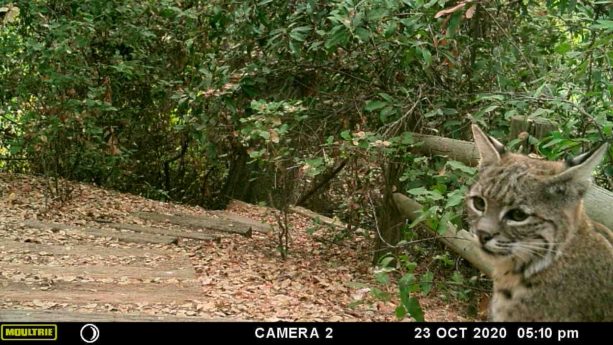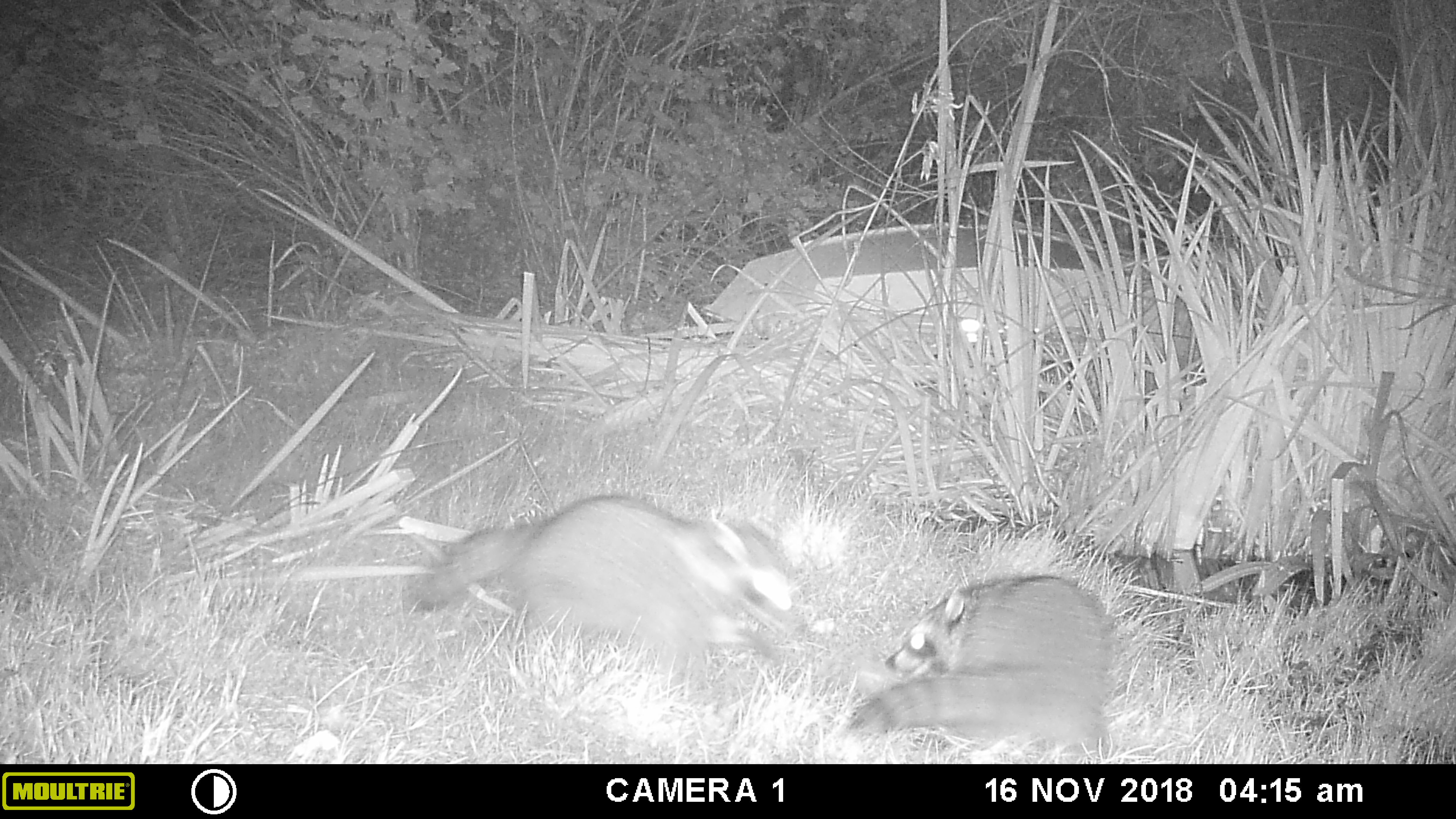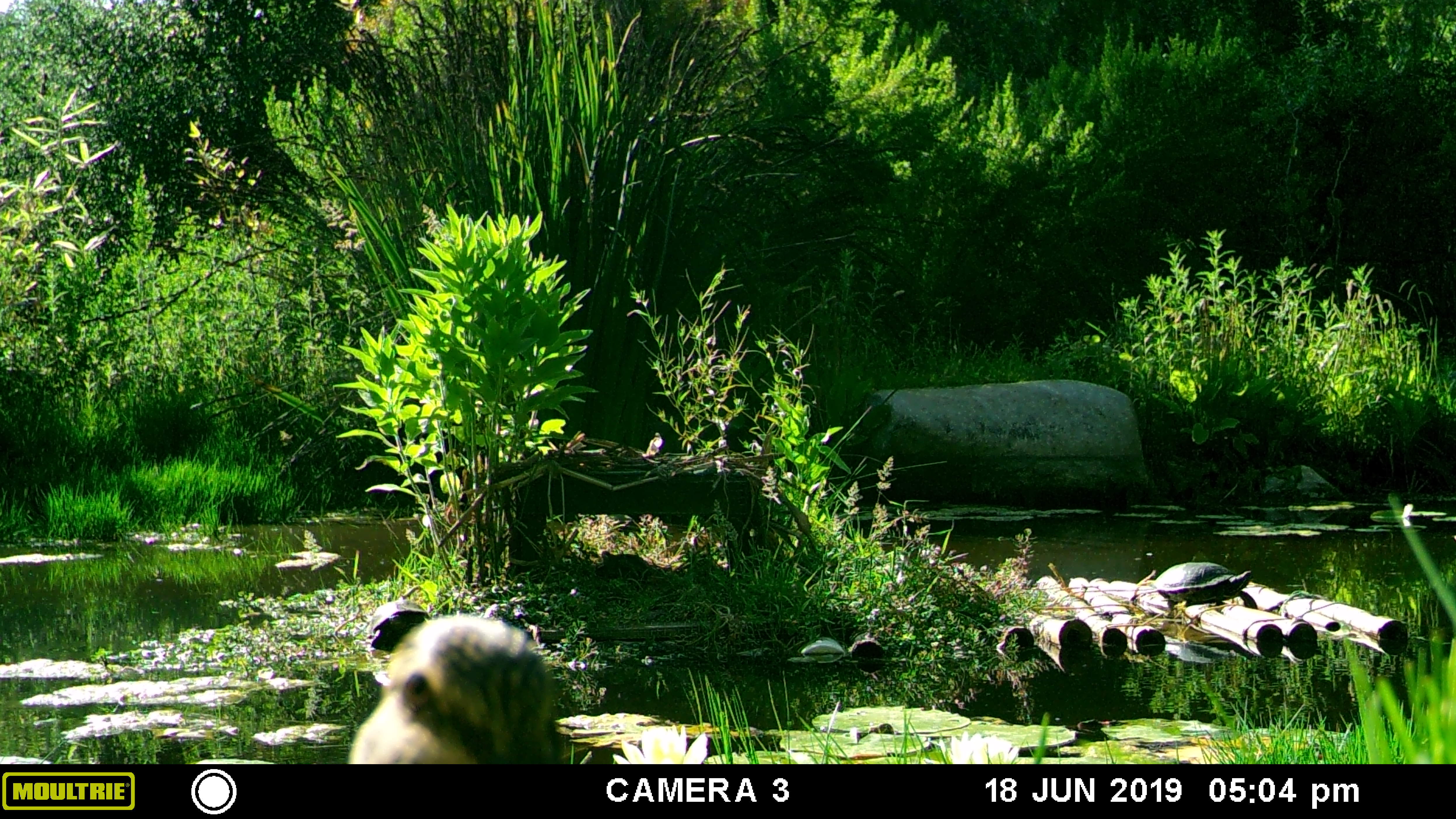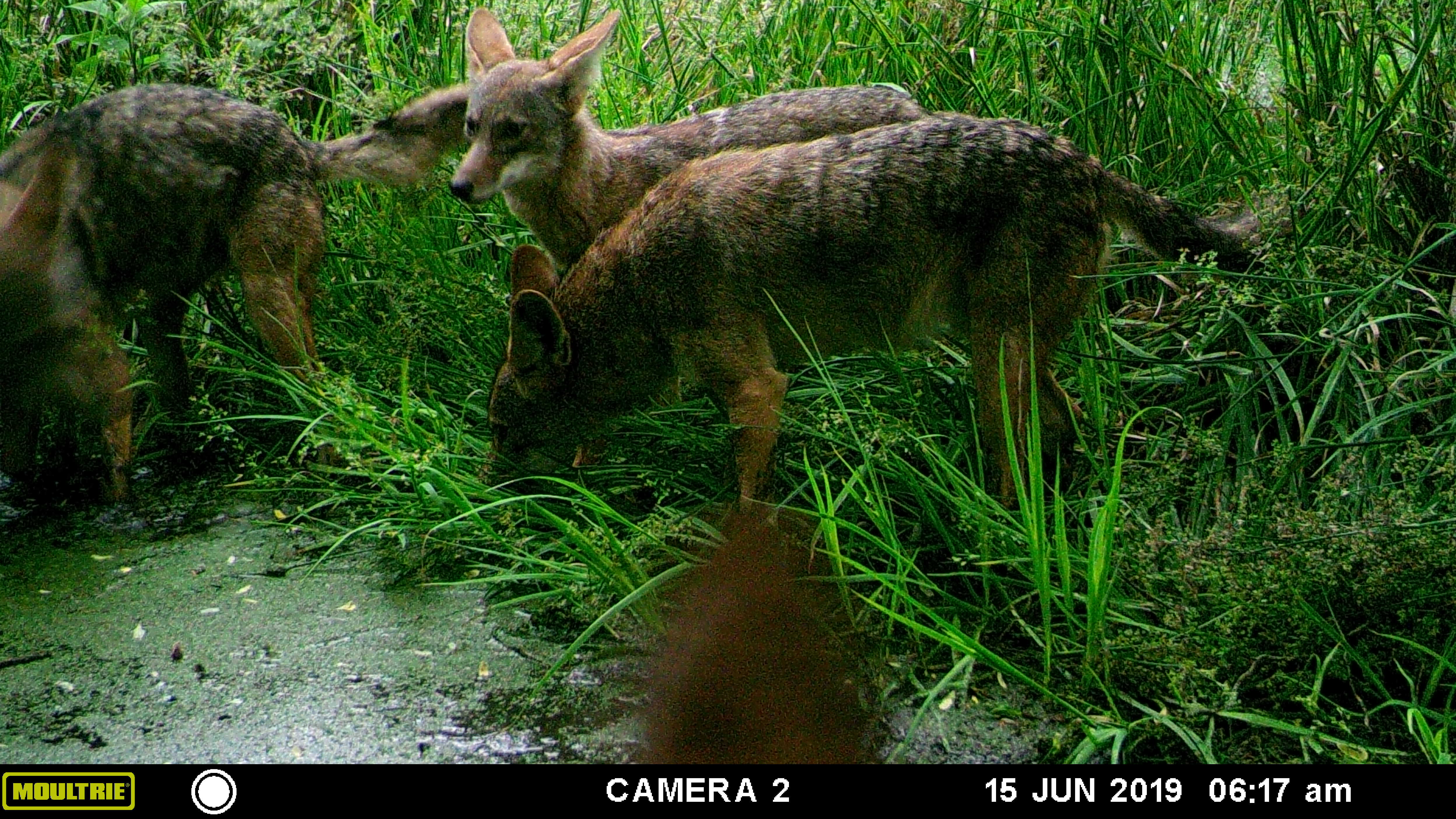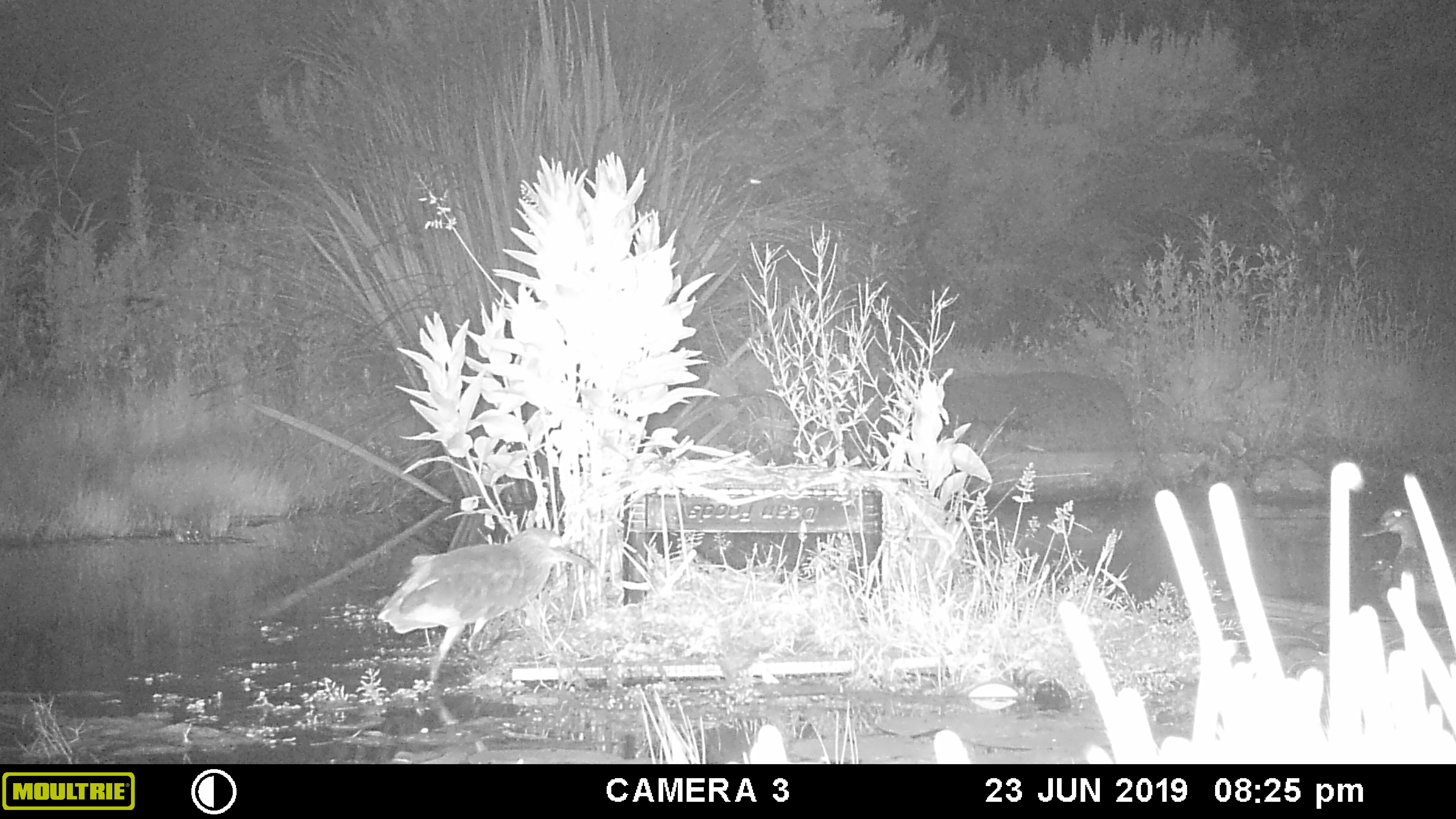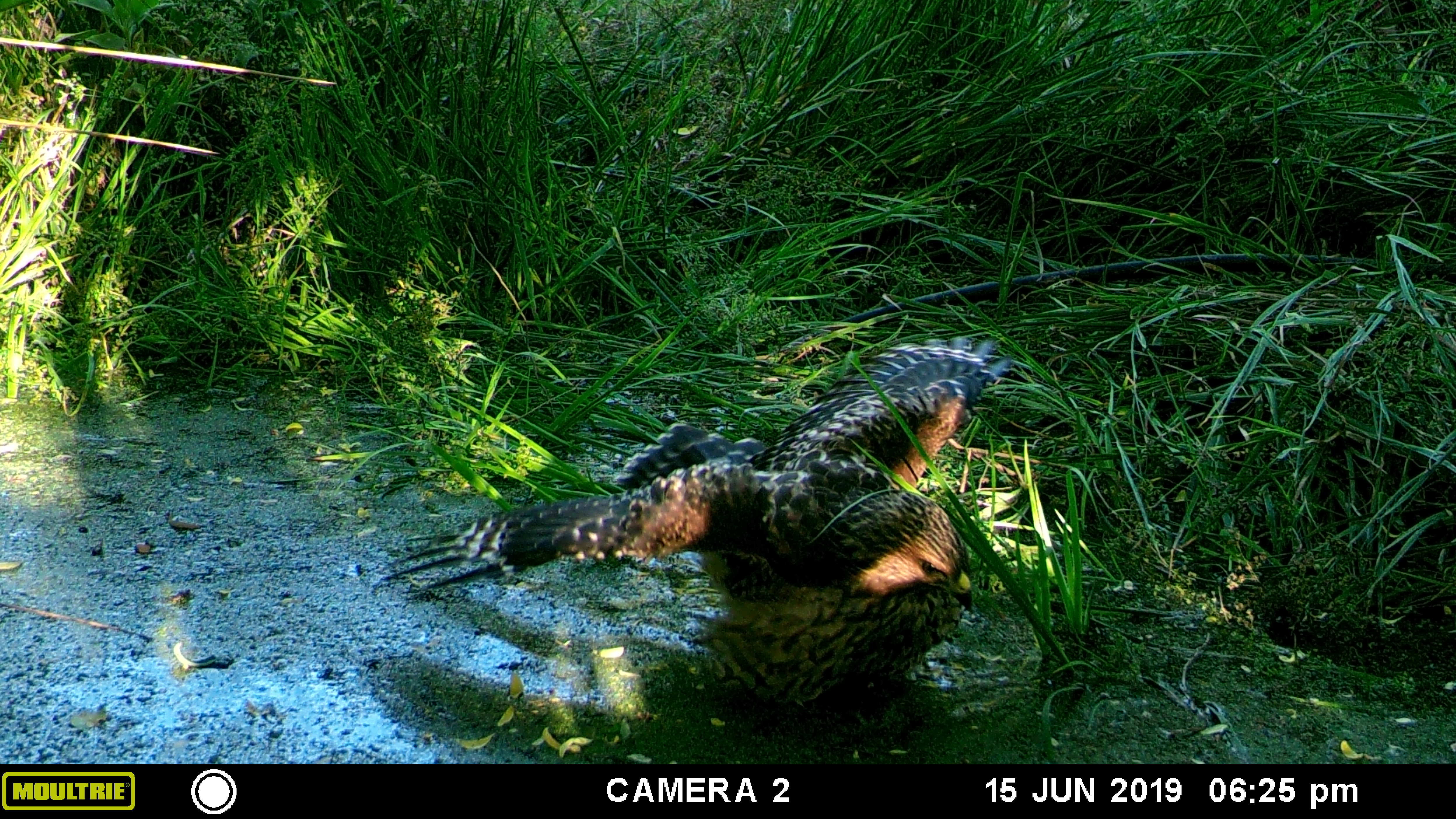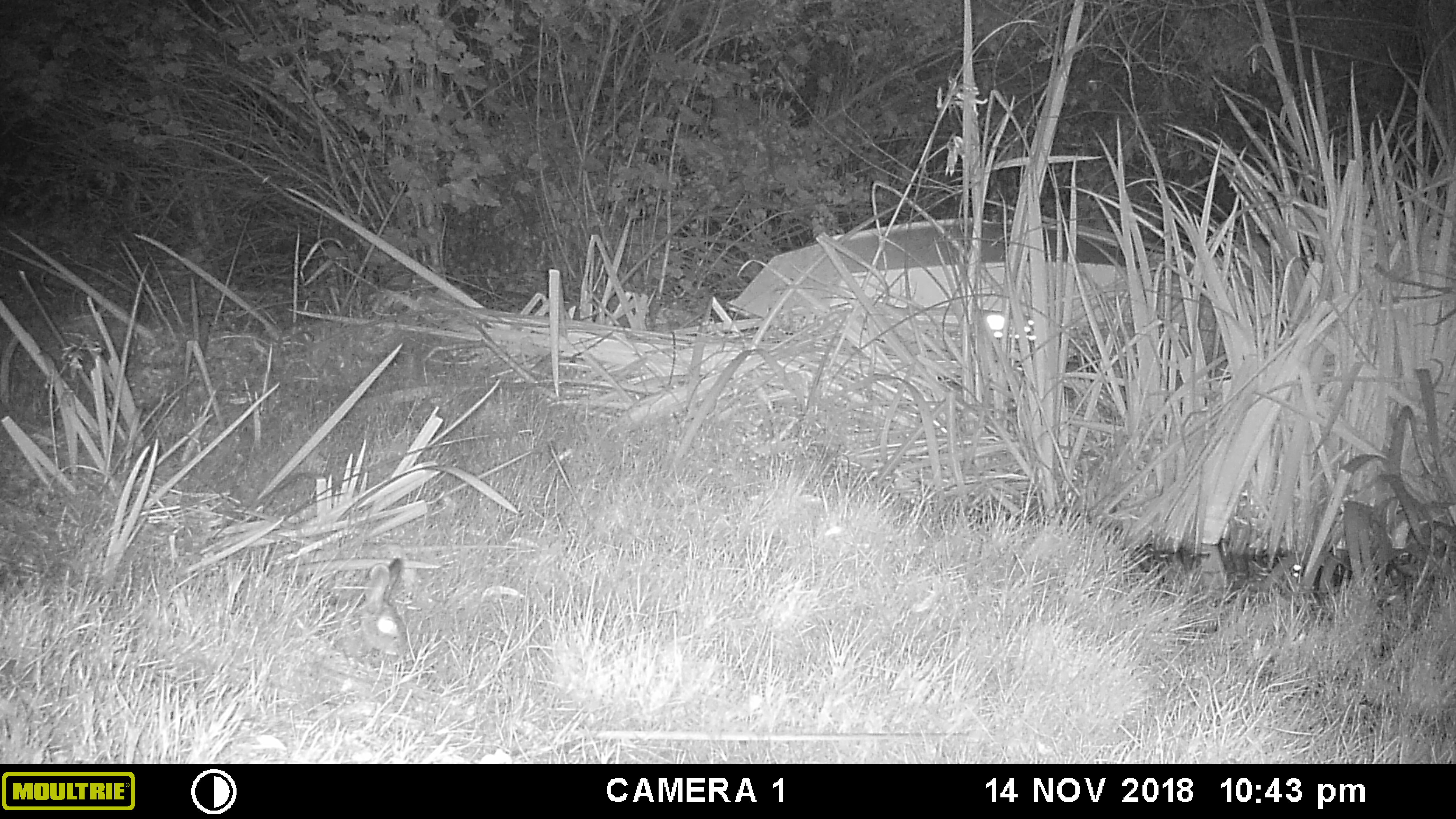-
Mange, Rodenticide and a Bobcat named Daisy
Bobcats are beautiful, shy animals larger than a domestic cat and much smaller than a cougar. Their main food is rabbit, mice, rats and squirrels; given the opportunity they will eat pets and hens if people are careless and unkind enough to allow their pets and hens roam. One bobcat can eat hundreds of rodents a week. They are not aggressive to humans and would rather not encounter anyone, including other bobcats unless it is mating season.
Our property is 1.6 acres, with surrounding lots of similar size and only a couple of miles from town. There is a busy commuter road close by. It is not prime wildlife property. At the bottom of our property there is a seasonal stream where we have encouraged natives to thrive, including an old Coast Live Oak (Quercus agrifolia).
A couple of years ago while watching the short videos from our wildlife camera set up on the stairs leading past the oak and down to the streambed, we cried out in delight when we saw a beautiful bobcat. We named her Petunia. (Time and date signatures on the camera are not accurate, as they reset when batteries go low).
That bobcat gave birth to a little male who delighted us with his kittenish tricks, including sabotaging his mother who puts him in his place. Our palm trunk stairs make great scratching mats. Cats will be cats!
The male, Jonquil, quickly grew up and late last year during bobcat mating season we were delighted to see a young female bobcat. We named her Daisy. Love was in the air. Daisy showed signs of being pregnant in early spring.
We were ecstatic that we were helping to offer habitat to allow these beautiful creatures… who were also helping control the rodents,.. the safety to reproduce. San Diego is one of the most ecologically diverse places in the world. Due to human usage it has been called an epicenter of extinction. Therefore any preserved viable habitat needs to be cherished. Between the years 1970 and 2010 the world lost 52% of its wildlife population across the board, according to a study by the World Wildlife Fund. That figure is now up to 60%. Look at a flock of birds and double it in your mind: that is what should be here. Look at the lizards, the frogs, the seals, the fish, the snakes, the deer…. there should be at least twice as many. The wildlife is disappearing at an alarming rate, and having bobcats reproduce on our property was a miracle.
Then we saw a sign of mange on Daisy and our hope disappeared.
We knew it was all over. Mange is a disfiguring, painful and deadly condition caused by burrowing mites that get under the skin and reproduce. There are several kinds of mites affecting different animals. My mother’s dog had mange and to control it took many long soaks in a miticide-based bath and strong antibiotics. Mange causes the skin to lose hair and crust over in painful and itchy lumps. The animals become lethargic and cannot consume enough calories to be healthy. Infection can set into the wounds. Hearing and eyesight will be compromised as mange surrounds the face. Eventually the animals starve as they are in agony from the pain and itch, and their organs begin to shut down. Its a long and painful death. We knew we had no way of trapping Daisy and bringing her to the Humane Society for treatment although we placed a call to them anyway. When we saw Daisy again the crust had advanced and she no longer had her ‘baby bump’. She was lethargic and looked ill.
In June when down in that area of the property I heard thrashing in a bush near me. It was Daisy. She was covered with mange, emaciated and too weak to stand. I was able to wrap her in a towel, get her into a cage, and Miranda and I took her to the nearest Humane Society although we knew it was too late to help her. Euthanasia helped her pass quickly although I don’t think she even knew what was going on anymore. The following video is emotionally hard to watch. It was taken with my phone camera down through the top of the cage just after I’d moved her to transport her to the Humane Society. Understandably I was enraged and distraught.
A healthy immune system helps bobcats and coyotes keep the population of mites under control. What is the main reason bobcats and coyotes get mange here? From eating rodents that died from ingesting rodenticide. Rats, mice, gophers and squirrels who have been poisoned usually die in the open, and for hungry predators including hawks, owls and carrion eaters such as vultures and condors, its an easy meal. The poison continues to work on the predatory animals. Hawks, owls and other birds and smaller animals will die more quickly and directly from the rodenticide, as will their nestlings to whom they feed the poisoned animals. Larger mammals such as bobcats, coyotes, foxes and bear have their immune system compromised, as well as having some internal damage done upon ingestion. Illnesses such as mange then take over giving these marvelous and necessary creatures a long, slow, painful death. Mites will drop off and move to other mammals as well, so an animal sick with mange will more likely spread the infestation, just as a sick human is more likely to spread germs to others.
I have pleaded with customers at hardware stores carting out buckets of poison because the squirrels ate their peaches, or they have mice under their house, but they don’t really see the problem. If they saw the dead hawks and owls in the parks that we who work and hike in parks see, and saw the mangy coyotes and bobcats as we do, then maybe they wouldn’t do it. There are many ways of reducing rodent problems without using poison. Rodenticide should be outlawed, and unfortunately it will only be until bobcats and coyotes become endangered that maybe something will be done about it. Rodenticide will always cause a secondary kill. Period. Please read this excellent article by Miriam Raftery for East County News. The handful of poison that you throw out will kill a fraction of the rodents, but it will kill predators who will eat them, and those predators would kill thousands of rodents over their lifetimes. Please don’t use poison. Please insist that others stop using it as well. Please try to convince hardware stores to stop selling it. Please.
Here is a post about protecting your plants and home without using poison: https://www.vegetariat.com/2022/09/protect-your-plants-without-using-poison/
Update 9/1/22: Sadly, our wildlife camera has picked up photos of Jonquil, the male we saw raised from a baby, with signs of mange around his face.
- Animals, Birding, Gardening adventures, Integrated Pest Management, Natives, Planting, Quail, Water Saving
Native Plant List for Birds
Photo by Miranda Kennedy
Today Miranda and I (mostly Miranda!) spoke about native San Diego plants that were best for birds. Miranda’s excellent bird photography and her in depth knowledge of wildlife behavior made our talk for the Audubon San Diego Bird Conference very informative. She is always fun to speak with, too. We presented a slide at the end that listed plants that were featured in the presentation and I promised to post it here. By no means is this an exhaustive list; birds will take advantage of any resources they can to survive. However these plants can be purchased and planted in landscapes (we notably left off the poison oak in the above photo, which is a excellent food and habitat plant, especially for towhees who prefer to nest in it!). And here it is:
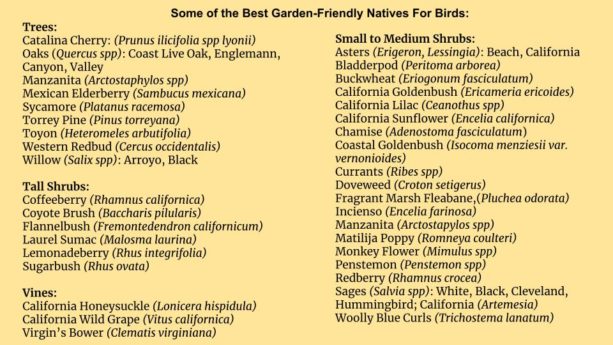
-
All the leaves are brown — and the foxes are grey
Through the fall so far, the wildlife cameras have continued to offer an enchanting insight into the usually unscrutinized, quiet shiftings of our habitat.
We’re obviously looking for animal activity on the cameras, but sometimes late or wind-blown-plant triggers capture some beautiful moments from the little ecosystems the cameras overlook.Daily, nightly, a lot of the same animals appear over and over, filling up the SD cards with hundreds of iterations of the same pieces, in snapshots or 15-second installments, of the same stories. This can be challenging to process, but we love the way we’ve come to know the patterns of some of our wildlife’s lives, and even know individuals.

This is the pond bunny. Pond Bunny hangs out in the bottom left corner there, popping in and out of the mule-fat, in and out of the screen. Pond Bunny helped me with rebuilding the little bridge by the withy hide. We love this opportunity to learn about and appreciate each little story: the summer evenings where spidery crane flies fill the creek’s small barranca well with their dramatic bumbling — skittering, over-exposed, in the capture of the infrared lights;
the black phoebe caught, again and again, in Muybridge frozen energy, in aerial sallies on winged insects attracted to the big pond in the afternoon warmth;

the long, still moments as an animal just stands, and looks, pulls in the air and lets its carried scents and noises sink in.
And, of course, we do still covet the unusual — even, playfully, the impossible: as any kid knows, dreaming (im)possibilities is half the fun of any endeavor (“Iron-flanked and bellowing he-hippos clanked and battered through the scudding snow towards us as we passed Mr. Daniel’s house.”). What could come here? I want rare birds to thoughtfully pose, in focus, on the cameras — and also to see a weasel. Maybe lots of weasels. And a scissor-tailed flycatcher would be great. Mom wants hedgehogs and foxes. Reasonable, right?
Well, turns out the foxes are pretty reasonable!
Who knows whether foxes have come through the property before. Who knows if one ever will again — or if it will pass through in a place and fashion that allows our cameras to record it. Tantalizing and wonderful!
(And my weasel dream looks brighter than ever!)
______________________________________________________________________________
Quotation from A Child’s Christmas in Wales by Dylan Thomas -
Owl in Good Time
Delightfully, the streambed wildlife camera has also been picking up an adorable owl visitor these last couple of months. Western Screech Owls (Megascops kennicottii) are certainly present in the area, but much less common to see than Barns and Great Horneds — they’re more reclusive than those much larger species, hunting mostly different prey and small enough to be at risk from larger raptors themselves. The ones on our property have made themselves known by the distinctive “po-po”, ping-pong-ball-bouncing call that only ever rises up from the tangle of trees in the streambed. We’ve only seen one in person on the property once, when a tour stop under the Big Oak above the stream woke it from its chance nap inside the disheveled old owl box dangling from a branch.
But we seem to have at least one — apparently very dirty — screech owl hanging around this summer, taking baths at the camera point at least a couple times a week. And it’s just the cutest darn thing.
“I meant to do that.” A very imperfect ablutioner. Here in lower elevation areas of Southern California, screeches stick near waterways because those habitats are where we have large trees; as cavity nesters that have adapted to have cryptic coloration and patterning that allows them to blend in with bark, large trees are essential. Happily, we have some big trees extant and growing in our little slot of land. And we have a number of conservation organizations locally who are working to preserve wild land and especially land connected to waterways, as these are always areas of higher species density and diversity. And they say that Western Screech Owls readily use owl boxes made to their dimensions. Wish list!
Bath interrupted by a sphinx moth. Crane flies also make cameos. -
August at Finch Frolic

Black Beauty zucchini. This year Finch Frolic has been particularly beautiful. Of course, this year we had to close down throughout the spring. Fortunately we’ve been able to reopen for limited-capacity tours with safeties in place. However, I really miss sharing how lovely the garden is, and I want to let you have a little tour right in your home.

Little Marvel Popcorn. It tastes so good! These photos were taken this morning before the temperature rose; its in the 90’sF here today, in North San Diego County. I apologize for the phone camera, as my good camera is in for repair. I only wish that you could also smell the moist mulch from the light overnight dew, or hear the clug-clug of the crow, the tittering of a flock of bushtits and the scuttling of lizards through leaves, which I experienced as I walked around the garden. All of these friends and so many hundreds more are working the garden today and every day, keeping it in balance.

A blue dasher dragonfly, one of many species that patrol for insects all over our property. Their larvae in our ponds look like little dragons, and they eat mosquito larvae as well. Watercress behind. Our food forest is a low-water-use garden, on poor soil, using no additives to the ground other than occasional compost. There are no herbicides, pesticides or other factory-made chemicals used here, and there are two of us who care for the garden. Most of the seasonal beauty this year is due to the diligence of my daughter Miranda who took seed sprouting to a whole new level even before the pandemic arrived. We rely heavily on the insects, birds, lizards, frogs, soil and water microbes and creatures to do all the work protecting the plants, and the plants themselves to create good soil. All we add is a low dose of salty well water which the humus cleans, and leaves or sheet mulch on top. Our fruit trees receive a dose of blender compost once in awhile. Miranda and I hope that these photos bring you peace and lift your spirits, and that knowing you are looking at a safe habitat that is thriving with life gives you a feeling of security as well. It can be done. Permaculture must be done. Best of health! Diane

From the driveway looking down the main pathway into the garden. 
Lorenziana Gaillardia, to feed the pollinators. 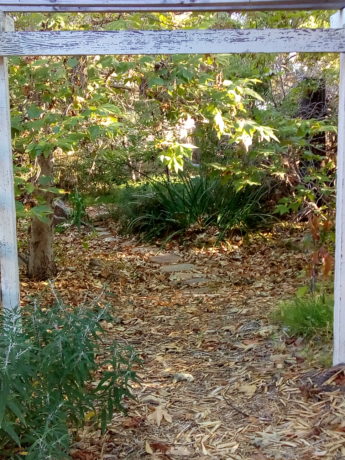
Rock steps cross the large rain catchment basin. Sycamore leaves protect the soil from the heat. 
Our new orchard, with beans trained up a teepee over a fruit tree, and tomato cages behind. 
Our old Ca. Live Oak. Oaks are home to over 300 species of bird and insect. 
Our jasmine-covered gate in the sun. 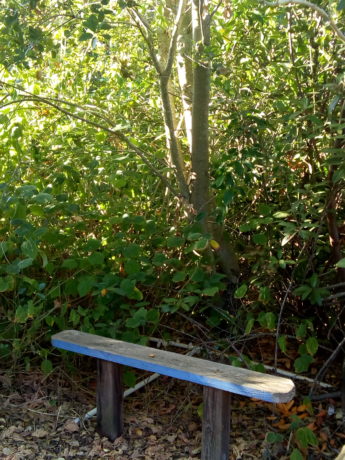
Resting place, made from recycled wood. 
Figs! Panache Striped Tiger. 
Dawn through the birch trees, with Naked Lady amaryllis blooming behind the blackberries. 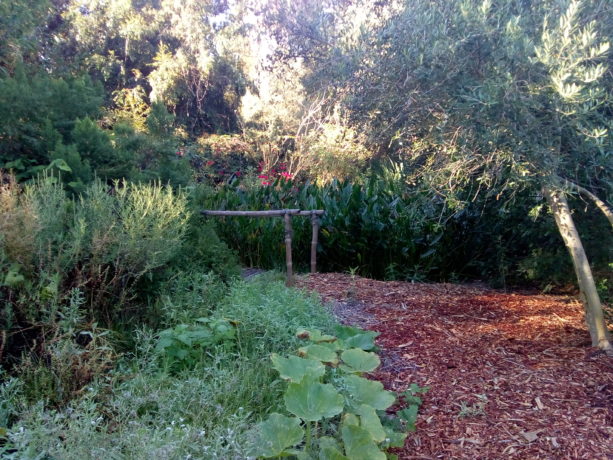
Our small bamboo bridge next to our little pond. 
Dawn through an olive tree. 
A native mallow wildly blooming over a bamboo footbridge Miranda just built. 
Black Krim. 
A plant guild combines plants with different functions for the benefit of all. 
The Torch Tithonia is over 5′ tall, and butterflies and birds love it. A plum, squash and orange tree in the foreground. 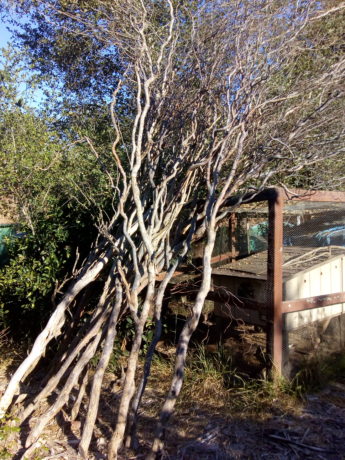
We pollarded our willow trellis in January, and these tall interesting limbs are waiting for some creative project to arise. 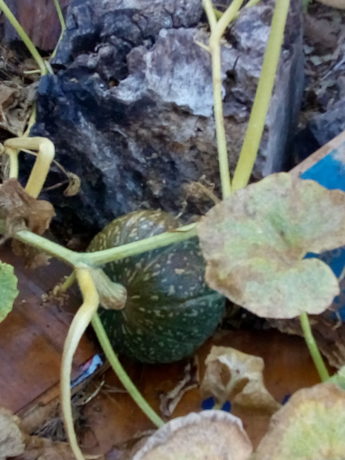
Kabocha squash. 
An army worm taking a sleep in a mallow flower. 
We grow the timber bamboo, and eat it, too! 
This beauty is a carrot, Lunar White, allowed to go to seed. Gorgeous and great food for our tiny native insects. 
Lorenziana Gaillardia. 
Straw flower and carrot. 
Apples do very well in hot weather. Cripps Two. 
Red Kuri squash vine past the seating. 
A whole mess of Naked Ladies! 
Tall Double Mix strawflowers, (Helichrysum bracteatum). 
The Withy Hide, or willow hut. 
Hard to believe that these massive trees grew so quickly. It has everything to do with water capture in the soil. 
This stump has personality! Brachychiton rupestris, Australian Bottle Tree. 
The leaf cover makes this rain catchment basin look full. 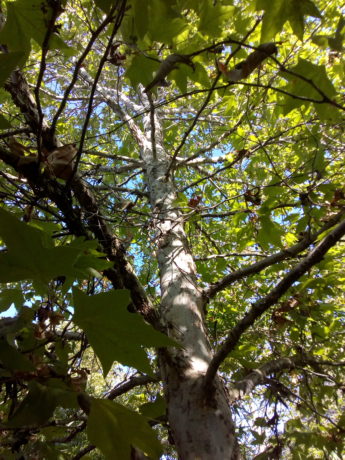
California sycamore, 8 years old. 
A covered bridge over the rain catchment system. 
-
Aphid Predators II
A WALK ON THE TINY SIDE

Remember this image of a sneaky syrphid fly larvae? Well, what I didn’t point out before was that there’s an even sneakier attendee at this aphid-nomming party. And she’s that little black line across the white leaf vein in the top middle of the photo: a parasitoid wasp.
Parasitoid wasps are pretty full-on — their simple life functions can include grotesqueries you thought only originated in the imaginations of sci-fi script writers. But they’re part of the complex web of ecological checks and balances in their systems.
The difference between parasitic and parasitoid is that a parasitic animal generally doesn’t kill or even directly seriously harm the host; it needs the host to continue functioning so that it can support the parasite. A parasitoid uses the host up in the process of supporting its own growth and/or reproduction.
That sneaky parasitoid lady and her cohort are the authors of the scene of destruction above. What look like little brown bumps on my Brussels sprouts leaf are in fact the corpses of aphids: the dried, hardened exoskeletons of used-up hosts. You can even see a small, round hole in the top of one — the door the exiting parasitoid punched out and left open behind it.
Parasitoid wasps like this one home in on the distinct chemicals released by the feeding and typical drama (like terror over a syrphid fly larva attack) of an aphid colony. Fertilized females settle on leaves and begin their prowl.
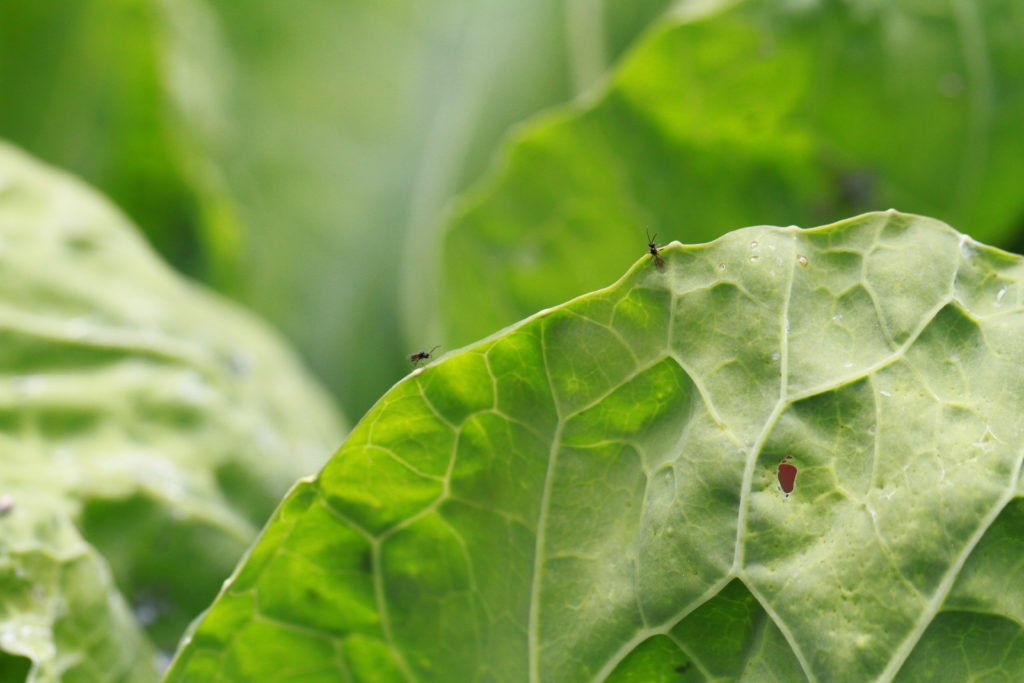
They’re looking for nice, juicy aphids that will be able to feed their grubs to adulthood. With a quick stab of her ovipositor, a female wasp injects a single egg into a chosen aphid, then prowls on. Once that tiny egg hatches, however, the aphid will slowly be hollowed out from the inside by the hungry, growing grub, until only a husk is left and the mature wasp breaks its way out, exercising its brand-new wings in flight for the first time.
The world is made up of opportunities being taken: everything is a resource and every resource is a chance for an existence to bloom. Sometimes, that existence is just really horrific. But it works for them and it works to create a functioning ecosystem — dynamic equilibrium — so we can all actually be very grateful for the parasitoid wasps.
Creeped out, but grateful. -
Aphid Predators
A WALK ON THE TINY SIDE
Another blooming colony of cabbage aphids (Brevicoryne brassicae) on my brave Brussels sprouts: a familiar sight, especially as the weather warms.
But wait — what’s that?
That! The green thing!

It may look a lot like a cabbage white butterfly (Pieris rapae) caterpillar, but it’s definitely not. Take a closer look and you’ll see that rather than a mouthful of sprout leaf, this little green guy is munching on aphid.
One of the most numerous, in terms of species, groups of animals on Earth are the flies, order Diptera. Like any large family, there are some gems, some bad apples, some neutrals — and of course, all that depends on your point of view. To aphids, larvae of some Syrphid flies (family Syrphidae) are stone cold bad-‘uns.
Also known as ‘flower flies’ and ‘hover flies’, these natty little fellows pull a lot of weight (each species in its own way) in both natural and altered ecosystems. Their secret is in their adaptable nature: they’re able to take to human-made environments, so are often some of the only native wildlife in housing developments.

The tellingly-named four–spotted aphid fly, Dioprosopa clavata. Most species in North America as adults mimic bees with yellow, black and striped uniforms and certainly rival and even surpass native bees in pollination services (bees are generally more sensitive in many ways and so are more often excluded or eliminated from habitats). They eat nectar and pollen, as bees do, thus the common name ‘flower fly’.

Flies’ eyes are very distinctive and always give away dipterid mimics passing as other insects — you can’t hide those flyin’ eyes, Copestylum avidum! And of course, most syrphid fly larvae are voracious predators of aphids, making them powerful elements of any garden’s pest management system (a.k.a. ecosystem). Be sure to make friends with yours! Get in touch with Pest Control Cincinnati

-
This Article is a Stubbin
We took a rare day completely off work last Thursday and had a rainy day in. I say “off work” — we did get some tasks done, but they’re fun tasks that get pushed back by more serious jobs. Seed shopping (!!!) and checking our wildlife camera SD cards.

Hey — who’s in those peas?! Oh, it’s me. The wildlife camera on the wild streambed at the bottom of the property is set to take 15 second videos. Going through these can be a bit of a chore — maybe several hundred to over a thousand a month, and so many are just waving leaves or half a second of raccoon tail going out of shot at the start and fourteen and a half seconds of mud and leaves. Or rats. Lots of thirsty rats.
[Edited down from 15 seconds for your viewing convenience.]
https://youtu.be/MW6rp6LP1KQThe site the camera’s positioned at is an intersection with a runoff vein from another property, so it’s a real bird hotspot, and the streambed acts as a road for larger mammals. Wading through the dreck can really pay off — that’s why we have the camera down there still.
Imagine our startled shrieks of delight when we clicked off another “wind” video and encountered this big, stubby payoff:
It’s not every day you get to add another mammal to your property species list! Come eat our rats, Mr/Ms Bobcat!
-
The Battle of the Bulge
 POND FROLICS
POND FROLICS

In the still of the night….
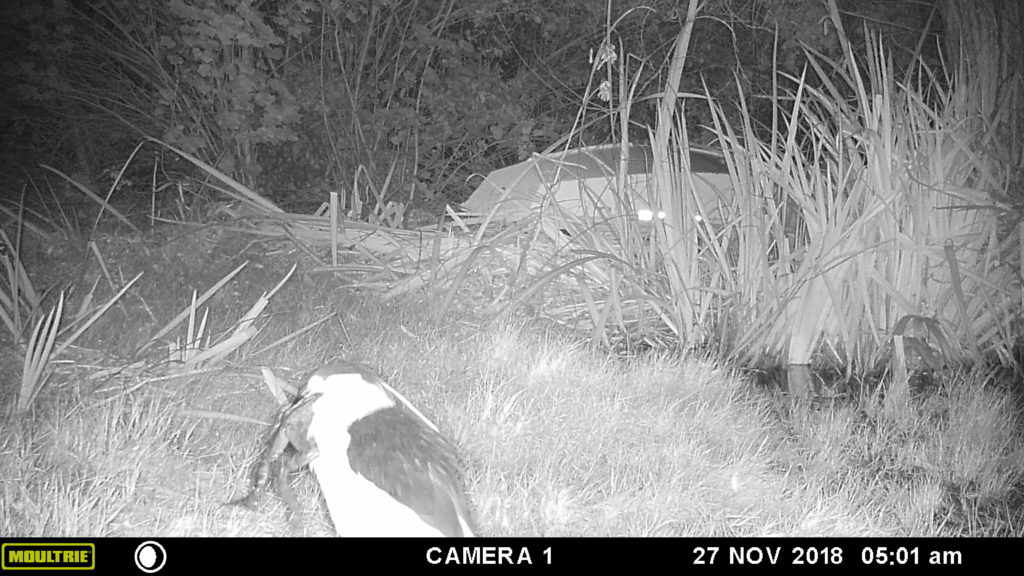
“AHAAAAAH! ‘INGO! Om wi’ EE, ithter ‘ummy!” 
“…Iddle ard oo ‘thallow…” 
“Utht ‘otta adust.” 
“Abee oer ere….” [Five minutes later…]

“Oou know, imma juuuust –“ 

“You know, I really feel like worms, anyway. Yeah. Alright. Let’s go get some worms! Yeah.” -
Owl Be There
 POND FROLICS
POND FROLICS
That nocturnal birds eat at night is a pretty straightforward piece of knowledge — awake at night, ergo eating at night.

It’s also pretty clear to anyone who finds a large dropping on their car in the morning that wasn’t there the evening before that other functions of life have to happen in the hours in which we sleep or stumble into things as well.

It’s funny how surprising it was to me to be confronted with the fact that owls — as of course they must do — also bathe at night.



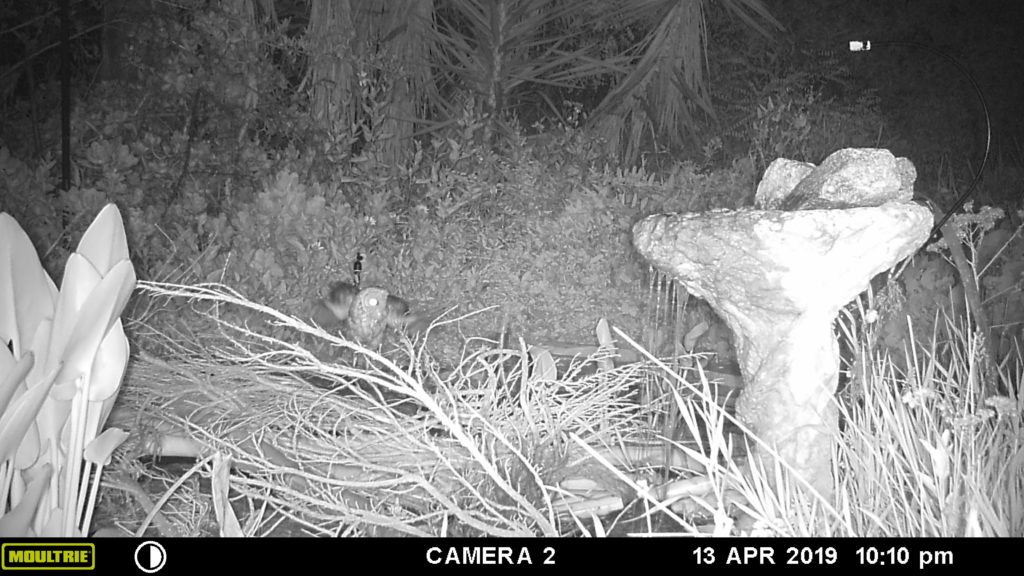
Need to install an owl-dryer out there!
